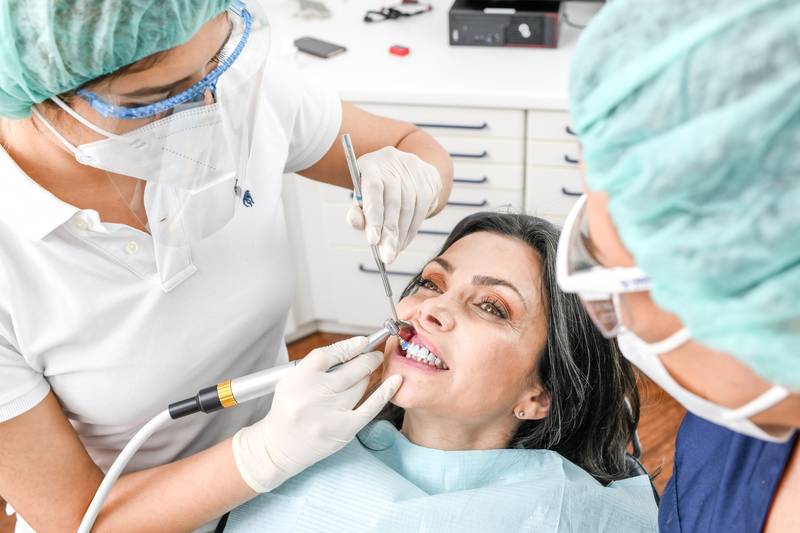The advance of digital technology is evident in almost every area of dental treatment. According to the Cologne-based Association of German Dental Manufacturers (VDDI), the key trends that will be addressed at the upcoming International Dental Show (IDS) are the improved preservation of teeth and modern methods for increasing the degree of individualisation in prosthetics. The 1,700 or so exhibiting companies from Germany and abroad are working hard to ensure that their innovations will be ready in time for presenting to the trade visitors at the next IDS. The world's leading trade fair for the dental sector takes place in Cologne from 20th to 24th March 2007. This year the dentists and dental technicians can look forward to a wide variety of highlights that reflect the latest in dynamic developments for the sector. Digital technology is becoming increasingly important for day-to-day surgery and laboratory work. In view of the many new technical systems and processes available, the VDDI states that dental advances are today heavily influenced by, for example, digital measuring technology and image processing in the dental surgery, and by computer-aided design (CAD) and the use of milling robots for partial production in the lab. "Thanks to state-of-the-art diagnostics and treatments, people today have a better chance than ever before of retaining their teeth and hard tooth structure well into old age," sums up Dr. Martin Rickert, Chairman of the VDDI. "But if they do need dentures, prosthetic dentistry now offers a wide range of options that are closely aligned with patients' needs for prosthetics that are as close to natural teeth as possible." In a unique, comprehensive presentation, IDS 2007 will show how advances in dental treatment can be put into practice. The largest IDS of all time will offer an ideal forum for trade visitors to gain an insight into all of the issues currently facing the sector - from improved versions of familiar methods and materials to impressive innovations in digital processes for diagnostics, treatment and dental technology. The ongoing trend towards system solutions reduces communication discontinuities, boosts work efficiency and enhances financial results. Some examples follow: When it comes to preventive care, long-term approaches to the preservation of teeth and gums are of particular importance. It's essential to motivate patients, to impress upon them the importance of regular visits to the dentist, and thereby to increase the chances of early detection of dental problems and diseases. We have a variety of modern measures at our disposal, such as individual risk assessment - i.e. dental diagnostics, including the use of molecular-genetic methods. That means individual care plans can be drawn up for patients, including professional cleaning, supra- and subgingival curettage and oral hygiene at home. There will be lots on show at IDS in all these areas. Endodontics also play an important role in tooth care. New in this field are enhanced nickel-titanium files, operated either mechanically or manually. These feature an optimized shape better adapted to the contours of root canals. At the same time, improvements in root-canal disinfection - an especially important aspect of successful treatment - have made this process safer. Endometry and digital X-rays enable more predictable and controllable results. On a more general level, enhanced surgical hygiene has important prophylactic consequences. Here, too, there are changes on the way. For example, the latest recommendations from the Robert Koch Institute propose new hygiene standards and routines for Germany. Industry specialists will be presenting a large number of innovations at IDS that are related to infection protection, hand hygiene, personal protective equipment, risk assessment for dental instruments and their preparation, hygiene for surfaces, devices and water-channelling systems of the treatment unit, the disposal of surgery waste, and many other aspects. In the end, it's the patient who profits from all this effort and expense. Dentistry today is increasingly concerned with providing preventive care and dental treatment tailored as closely as possible to the individual's needs. This means providing patients with the right advice from childhood to old age with regard to oral hygiene, tooth care and dental prostheses. Properly advised by their dentist, patients are able to make an informed choice within the broad field of prosthetic alternatives. And whether the decision falls in favour of good-quality basic care, a mid-price solution or a high-end prosthesis will ultimately depend on the quality of that advice. The enormous variety in dental care today is particularly evident in the prosthetic field. On the one hand, we now have a range of natural-looking plastics plus high-performance adhesives for fillings. On the other, metal or ceramic are the materials of choice for inlays - and likewise for individual crowns and permanent and implant-supported bridges, although the trend today is towards high-quality, all-ceramic solutions, which are particularly biocompatible. As an alternative to partial and full prostheses, we are also seeing a more widespread use of both crown-and-sleeve coping and telescopic prostheses supported by either implants or abutment teeth. Both offer not only good functionality but also cosmetic advantages and enhanced oral hygiene for our ageing population. Alloys will continue to play a major role in dental prosthesis. There are currently over 1,000 different alloy types available as ceramic alloys for natural-looking ceramic veneer crowns or as cast alloys for full crowns and bridges. The latest additions to this class are palladium-free and copper-free alloys with a high gold content, which are suitable for a broad range of treatment and are especially biocompatible. The use of non-precious metal alloys is also gaining ground. Not only are these cheaper and likewise suitable for a broad range of treatment, but in some cases they can also be milled using CAD/CAM technology. CAD/CAM technology is also helping to advance the use of all-ceramic materials. Here, leucite-reinforced glass ceramics, aluminium oxide and zirconia are the materials most commonly used for single crowns, bridges and other prostheses. Zirconia, in particular, offers major potential in this field, even for occlusion-bearing lateral areas of the jaw. It is also ideal for speciality prostheses such as primary crowns in double-crown prostheses. Furthermore, all-ceramic prostheses approximate most closely to the light-reflecting qualities of natural teeth and therefore meet the highest cosmetic demands. The influence of digital technology is now unmistakable throughout the field of dentistry. For example, the use of digital X-ray imaging with photostimulable phosphor systems or other processes is gaining ground, as is the digital archiving of X-ray and intraoral images. Such technology is especially beneficial during consultation, since it provides a clear visual demonstration of the proposed treatment and can therefore play an important role in convincing patients of the wisdom of opting for a higher-quality solution. Today's digital camera systems can provide more detailed monitoring of surgical operations. Finally, the latest colorimeters, which provide exact readings of dentition colour independently of the actual light conditions, enhance cooperation between the dentist and the dental technician. The arrival of CAD/CAM technology has sparked a digital revolution in dental laboratories. Products needed for almost every type of dental work - from basic care to complex restoration jobs - can now be designed onscreen and then made quickly and easily in the lab or elsewhere. The trend here is towards the use of ergonomic CAD systems, high-definition laser scanners and fast CNC milling robots that are able to process a range of ceramic and metallic materials. Such technology can provide the dental industry with a real advantage, and IDS is the perfect place to find out about all these fascinating systems and what they can do. Implantology continues to take great strides, helped along by advances in microsurgery and the instruments used in this field. For example, state-of-the-art digital cameras are now used to provide dentists with onscreen, moving 3D images inside the mouth. Advances have also been made in the use of new bone-replacement materials. Another trend is the increasing use of high-grade implants made from zirconia. Effective teamwork between the dentist and the dental technician is crucial here to ensure that such high-tech prostheses sit comfortably in the mouth. New developments are likewise benefiting the field of orthodontics, where - alongside conventional bracket systems - deep-drawn systems are now also in use. In addition, the use of implants and mini-pins is now helping to improve the skeletal anchoring of orthodontic systems. "The new products on display at IDS 2007 precisely meet the needs of dentists and dental technicians from around the globe, so they will attract a great deal of interest," states Dr. Rickert. "IDS sets trends that are transported from Cologne all over the world and make an immediate impact." The dental trade fair regularly presents materials, devices and processes that go on to become successful worldwide. In other words, they prove to be useful, economical tools that result in advances at the international level. According to Dr. Markus Heibach, President of the VDDI, another aspect will be of particular interest to the trade visitors from different countries. "Globalisation is making the world a smaller place, and that's changing everyday dental work," he states. "New developments are opening up new opportunities for the market players. Nobody who wants to exploit these opportunities to the full can afford to miss IDS 2007." The International Dental Show (IDS), which takes place in Cologne every two years, is organized by the Association of German Dental Manufacturers, Cologne (http://www.vddi.dee), represented by its Society for the Promotion of the Dental Industry (GFDI). The trade fair is staged by Koelnmesse GmbH, Cologne. Note for editorial offices:
Photos from the last IDS are available in our photo database on the Internet (http://www.ids-cologne.de) on the "Press information" pages (click on "Photos"). If you reprint this document, please send a voucher copy.. More information: VDDI e.V. – Pressereferat - Burkhard Sticklies Fon: 0221-500687-14 Fax: 0221-500687-21
- Alter:
6283 Tage



